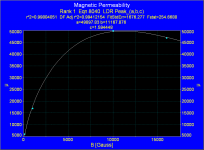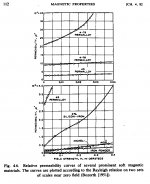Hi at all, i have a dude.
I bought a 10H inductor for a power supply tube amplifier.
I test the inductor and have 6H.
I talk with the inductor productor and he told me , that with the voltage and the current working with one 5Z3 tube the inductance will be 10H.
Is true this ?
Thanks
I bought a 10H inductor for a power supply tube amplifier.
I test the inductor and have 6H.
I talk with the inductor productor and he told me , that with the voltage and the current working with one 5Z3 tube the inductance will be 10H.
Is true this ?
Thanks
Does the manufacturer know more about inductors than you, or for that matter about anyone else?
Perhaps if you can link to a data sheet, or technical details about that inductor, as well as the technical details on your amplifier, then others may have a good chance of providing some advise to you.
Perhaps if you can link to a data sheet, or technical details about that inductor, as well as the technical details on your amplifier, then others may have a good chance of providing some advise to you.
The BH-curve of the core is not linear, so at low direct current the measured inductance is lower than at the intended operating condition.
Last edited:
My advice would be to bias it at the rated current.
Download the manual for the Marconi TF1313A component bridge and read the procedure for biasing a large smoothing choke for testing.
It was well known that inducters need to be biased to the DC value they will be operating at. This does not apply to tuning components in radios though.
Download the manual for the Marconi TF1313A component bridge and read the procedure for biasing a large smoothing choke for testing.
It was well known that inducters need to be biased to the DC value they will be operating at. This does not apply to tuning components in radios though.
how did you test and what equipment did you use for testing?
did you test it both the rated current flowing?
did you test it both the rated current flowing?
that is indeed doubtful, using that meter, the readings should have been higher than 10 without any current flowing...something like 15 to 20 H...
did you see the air gap? the lesser the air gap, the higher the inductance..
did you see the air gap? the lesser the air gap, the higher the inductance..
The inductance goes down with DC current. And it goes up with AC voltage (until it reaches a peak) due to permeability change of the iron lams (substantial 100 to 1 change, see below). The air gap moderates that 100 to 1 variation considerably, fortunately, but not entirely. The L meter only puts out a small AC voltage signal, so the iron permeability will be low.
Checking some Hammond 10H chokes with an L meter:
193M 300mA, 10H rated: 8.58H measured
193Q 500mA, 10H rated: 6.7H measured
193L 300mA, 5H rated: 4.19H
What is the DC current rating for the choke in question?
Results will depend on the AC signal level put out by the L meter. The L meter here puts out 1.24VAC at 93 Hz
Checking some Hammond 10H chokes with an L meter:
193M 300mA, 10H rated: 8.58H measured
193Q 500mA, 10H rated: 6.7H measured
193L 300mA, 5H rated: 4.19H
What is the DC current rating for the choke in question?
Results will depend on the AC signal level put out by the L meter. The L meter here puts out 1.24VAC at 93 Hz
Attachments
Last edited:
that is indeed doubtful, using that meter, the readings should have been higher than 10 without any current flowing...something like 15 to 20 H...
did you see the air gap? the lesser the air gap, the higher the inductance..
If it has an air gap the inductance should be pretty much independent of current.
Air gaps linearize inductance. Gaps reduce inductance values though, so gapped chokes are bigger and heavier for the same inductance. Gapped inductors can store more energy however, the magnetic field in the gap is much more energy dense than in the laminations (weird but true).
core saturation with dc current is the reason for air gaps, air cored chokes never saturate, chokes with iron does....
but we use iron cores so that the we get more inductance from the same number of turns that way....
i did a study several years ago with z11/M6 versus the H50/M58 core materials, and the results showed a 3 to 1 advantage of the M6 over the M58..
i wound a choke and it tested 6H with a certain gap, butt joined, but finally i settled for the gap that gave me 1H,
@smoking-amp, just how do manufacturers like Hammond rate their chokes?
but we use iron cores so that the we get more inductance from the same number of turns that way....
i did a study several years ago with z11/M6 versus the H50/M58 core materials, and the results showed a 3 to 1 advantage of the M6 over the M58..
i wound a choke and it tested 6H with a certain gap, butt joined, but finally i settled for the gap that gave me 1H,
@smoking-amp, just how do manufacturers like Hammond rate their chokes?
smoking-amp, just how do manufacturers like Hammond rate their chokes?
They probably use a Variac and LV xfmr to excite the inductors at 50/60 Hz somewhere below core saturation level, with a DC current source across the inductor with a BIG Cap in series with the AC source. Measure the L using an AC mA meter and AC V meter. L = V/(2 pi f I)
Make sure the DC current source has high Z at the AC frequency used. Ie, use a bipolar or mosfet adjustable CCS from some DC supply.
These inductance meters are going to kill the big iron choke business.
Iron core chokes DO vary with current. And Frequency!! They will never "read right" until the whole circuit is built. Yes, the inductance will usually peak at rated DC current-- they are designed that way, lots of figuring.
You will NEVER get the "right" number on a 10H 100mA 50/60Hz Power Choke with today's popular-price coil testers which apply <1V and <1mA and usually at a much higher frequency. There are going to be a lot of unhappy customers.
Anyway, if 10H makes good filtering, 6H is not much worse. (But I still say it will be 8-14H when run hard at line frequency.)
Iron core chokes DO vary with current. And Frequency!! They will never "read right" until the whole circuit is built. Yes, the inductance will usually peak at rated DC current-- they are designed that way, lots of figuring.
You will NEVER get the "right" number on a 10H 100mA 50/60Hz Power Choke with today's popular-price coil testers which apply <1V and <1mA and usually at a much higher frequency. There are going to be a lot of unhappy customers.
Anyway, if 10H makes good filtering, 6H is not much worse. (But I still say it will be 8-14H when run hard at line frequency.)
Once I bought a Hammond 158T, 1H+/-15% measured by manufacturer at 300mA. I measured it at the -15% i.e. 0,85H and I thought it's OK. But I didn't measure it at 300mA. I use ARTA limp to measure inductance. I connect a known capacitor in series with the choke and look for resonance frequency i.e. the lowest impedance. Is this method completely wrong? Should I expect lower or higher inductance in the real psu?
PS. In PSUDII simulations, cutting inductance to half doesn't make a spectacular difference.
PS. In PSUDII simulations, cutting inductance to half doesn't make a spectacular difference.
That should work, but the resonance freq. will change with applied AC voltage due to inductance change. (iron permeability change, moderated by the air gap)
I make my own iron cored chokes, so I can write with certain criteria that measured inductance with a RLC meters always is erroneous. Most of those bridges use about 1KHz signal at a very low level and without DC premagnetization. So discard this measurements, and try it in circuit.
Which part of Argentina are you from? I work in CABA but native from GBA.
Which part of Argentina are you from? I work in CABA but native from GBA.
Last edited:
- Home
- Amplifiers
- Tubes / Valves
- Inductance of inductor.

